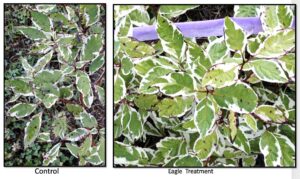Fungicides are important tools for managing ornamental plant diseases (Fig. 1). There are many different fungicides and numerous methods of classifying them. One way to classify fungicides is by their chemical structures or modes of action — the specific ways the fungicides kill a fungus. Fungicides that share a common mode of action belong to the same fungicide class (sometimes referred to as a fungicide family). Unfortunately, if a fungus is resistant to a specific fungicide, it is usually resistant to all the fungicides within that fungicide class.
Fungicides are also characterized by their specificity. Site-specific fungicides react with one very specific, very important biochemical process, called the target site. For example, a fungicide target site could be the specific proteins involved in cell wall biosynthesis, RNA biosynthesis, or cell division. Sites specific fungicides target these specific processes, which prevents the fungus from growing and ultimately causes its death.
Multi-site fungicides have multiple modes of action, so they affect multiple target sites, and simultaneously interfere with numerous metabolic processes of the fungus. Fungicide resistance occurs when a fungus develops a genetic mutation at the target site that reduces its sensitivity to a specific fungicide. Because they affect multiple target sites, multi-site fungicides have a very low risk of causing fungicide resistance because it is highly unlikely for a fungus to simultaneously develop all of the mutations necessary for resistance.
Site-specific fungicides, however, have a much higher risk of causing resistance because a single genetic mutation at the target site can change a fungus’ biochemical process so that it can still perform the needed biological function (cell division, membrane biosynthesis, respiration). The result is a fungus strain that is less susceptible or no longer susceptible to the site-specific fungicide.
If a single fungicide continues to be used, the fungicide-sensitive portion of the population is suppressed over time, and only the fungicide-resistant portion of the population remains, which goes on to reproduce and make up the majority of the population. Eventually, the fungicide is ineffective because this majority of the fungal population is no longer susceptible to it.
Minimizing Resistance
To minimize the possibility of fungicide resistance from occurring, implement a comprehensive management strategy before resistance develops. Some key tactics to include in your management strategy include:
- Follow good plant practices. Using disease-resistant cultivars, following proper planting and fertilization techniques, and sanitizing equipment reduce the reliance on fungicides, thereby reducing the risk of their over-use and the development of resistant populations.
- Use the recommended doses as stated on fungicide labels. Many fungicides have been extensively tested to identify the optimal rate. Cutting the rate results in a sublethal dose that is not only ineffective for disease management, but increases the risk of resistance.
- Minimize the number of fungicide treatments per season, and apply only when necessary. Excessive use of site-specific fungicides increases the likelihood of resistance. By reducing the number of site-specific fungicide applications, you reduce the likelihood of resistance development.
- Do not rely solely on one fungicide with a site-specific mode of action.
Use a diversity of fungicides with different modes of action that provide broad-spectrum disease control. There is no single, best fungicide. There are, however, multiple fungicides with different efficacies for different diseases (Fig. 2). Many single-site fungicides are highly effective by themselves, but you should tank-mix them with another fungicide from a different family, or rotate or alternate multiple fungicides to reduce the risk of resistance. The important thing to remember is that you should avoid consecutive applications of site-specific fungicides.
For this an additional information in this newly updated brief, see https://www.extension.purdue.edu/extmedia/BP/BP-71-W.pdf

